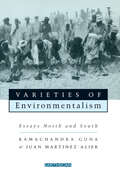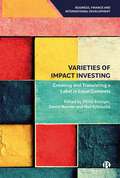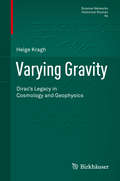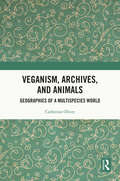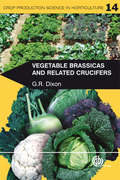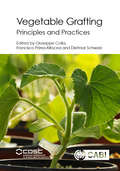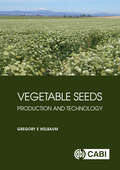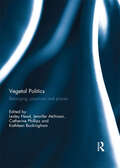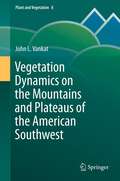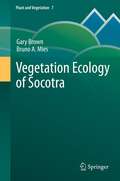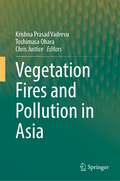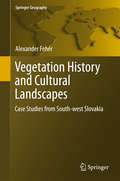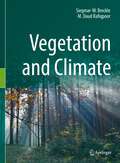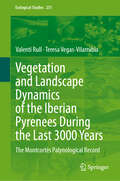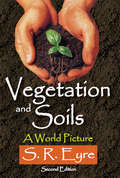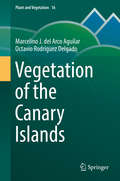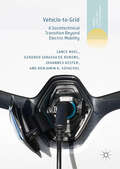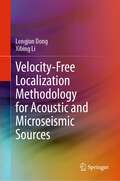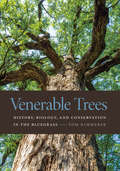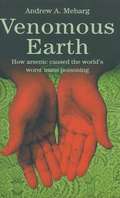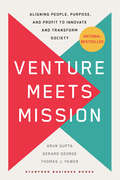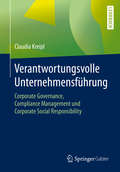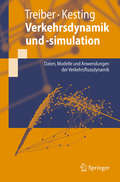- Table View
- List View
Varieties of Environmentalism: Essays North and South
by Ramachandra Guha Joan Martínez AlierUntil very recently, studies of the environmental movement have been heavily biased towards the North Atlantic worlds. There was a common assumption amongst historians and sociologists that concerns over such issues as conservation or biodiversity were the exclusive preserve of the affluent westerner: the ultimate luxury of the consumer society. Citizens of the world's poorest countries, ran the conventional wisdom, had nothing to gain from environmental concerns; they were 'too poor to be green', and were attending to the more urgent business of survival. Yet strong environmental movements have sprung up over recent decades in some of the poorest countries in Asia and Latin America, albeit with origins and forms of expression quite distinct from their western counterparts. In Varieties of Environmentalism, Guha and Matinez-Alier seek to articulate the values and orientation of the environmentalism of the poor, and to explore the conflicting priorities of South and North that were so dramatically highlighted at the Rio Earth Summit in 1992. Essays on the 'ecology of affluence' are also included, placing ion context such uniquely western phenomena as the 'cult of wilderness' and the environmental justice movement. Using a combination of archival and field data,. The book presents analyses of environmental conflicts and ideologies in four continents: North and South America, Asia and Europe. The authors present the nature and history of environmental movements in quite a new light, one which clarifies the issues and the processes behind them. They also provide reappraisals for three seminal figures, Gandhi, Georgescu-Roegen and Mumford, whose legacy may yet contribute to a greater cross-cultural understanding within the environmental movements.
Varieties of Impact Investing: Creating and Translating a Label in Local Contexts (Business, Finance and International Development)
by Philip Balsiger, Daniel Burnier and Noé KaboucheAvailable open access digitally under CC-BY-NC-ND licence. A new trend in ethical finance, impact investing aims to generate positive social or environmental impacts alongside financial returns. But what does it really mean and how is it practiced across different regions and organizations? This volume explores the malleability of impact investing and how it overlaps with the development sphere to give finance a new role. From global networks to the Global South, it compares diverse investing practices and discourses. Providing an original perspective on this emerging field, this is a key resource for the scholars of social studies of finance, economic sociology, management and organization studies.
Varying Gravity
by Helge KraghThe main focus of this book is on the interconnection of two unorthodox scientific ideas, the varying-gravity hypothesis and the expanding-earth hypothesis. As such, it provides a fascinating insight into a nearly forgotten chapter in both the history of cosmology and the history of the earth sciences. The hypothesis that the force of gravity decreases over cosmic time was first proposed by Paul Dirac in 1937. In this book the author examines in detail the historical development of Dirac's hypothesis and its consequences for the structure and history of the earth, the most important of which was that the earth must have been smaller in the past.
Veganism, Archives, and Animals: Geographies of a Multispecies World
by Catherine OliverThis book explores the growing significance of veganism. It brings together important theoretical and empirical insights to offer a historical and contemporary analysis of veganism and our future co-existence with other animals. Bringing together key concepts from geography, critical animal studies, and feminist theory this book critically addresses veganism as both a subject of study and a spatial approach to the self, society, and everyday life. The book draws upon empirical research through archival research, interviews with vegans in Britain, and a multispecies ethnography with chickens. It argues that the field of ‘beyond-human geographies’ needs to more seriously take into account veganism as a rising socio-political force and in academic theory. This book provides a unique and timely contribution to debates within animal studies and more-than-human geographies, providing novel insights into the complexities of caring beyond the human. This book will appeal to students and scholars interested in geography, sociology, animal studies, food studies and consumption, and those researching veganism.
Veganism, Archives, and Animals: Geographies of a Multispecies World
by Catherine OliverThis book explores the growing significance of veganism. It brings together important theoretical and empirical insights to offer a historical and contemporary analysis of veganism and our future co-existence with other animals.Bringing together key concepts from geography, critical animal studies, and feminist theory this book critically addresses veganism as both a subject of study and a spatial approach to the self, society, and everyday life. The book draws upon empirical research through archival research, interviews with vegans in Britain, and a multispecies ethnography with chickens. It argues that the field of ‘beyond-human geographies’ needs to more seriously take into account veganism as a rising socio-political force and in academic theory. This book provides a unique and timely contribution to debates within animal studies and more-than-human geographies, providing novel insights into the complexities of caring beyond the human.This book will appeal to students and scholars interested in geography, sociology, animal studies, food studies and consumption, and those researching veganism.
Vegetable Brassicas and Related Crucifers (Crop Production Science in Horticulture Series #14)
by Geoffrey R. DixonThe Brassica crops provide the greatest diversity of products derived from a single genus. As vegetables they deliver leaves, flowers, stems and roots that are used either fresh or in processed forms. This book covers the Occidental crops derived from B. oleracea(cole or cabbage group) and Oriental types from B. rapa (Chinese cabbage and its relatives). Both groups are of immense importance for human nutrition, containing vital vitamins and cancer-preventing substances.
Vegetable Grafting
by Giuseppe Colla Francisco Pérez-Alfocea Dietmar SchwarzThis book provides comprehensive, current scientific and applied practical knowledge on vegetable grafting, a method gaining considerable interest that is used to protect crops from soil-borne diseases, abiotic stress and to enhance growth/yield. Though the benefits of using grafted transplants are now fully recognized worldwide, understanding the rootstock/scion interactions under variable environmental pressures remains vital for grafting-mediated crop improvement. Vegetable Grafting: Principles and Practices covers: #65533; Breeding, signalling, and physiological and molecular mechanisms involved in grafting #65533; Beneficial effects of grafting including reducing disease damage and abiotic stress; #65533; Effects relating to the impact of grafting on fruit quality #65533; Applications and speciality crops. Including high-quality colour images and written by an international team of expert authors, this book provides up-to-date scientific data and is also concerned with translating science to the field. It is an essential resource for researchers, advanced technicians, practitioners and extension workers.
Vegetable Seeds: Production and Technology
by Gregory E WelbaumMost food and fiber crops are produced from seed. This means that the world's population is dependent on annual seed production for its food supply. Vegetable seed production is much different and more challenging than production of grain crops. This book explains the biology and technology behind producing, maintaining, and enhancing the quality of vegetable seeds from breeding through to the marketed product. It begins with six chapters on a broad range of seed-related topics: the importance of seeds, reproductive biology of plants, genetic improvement strategies, quality assurance of seed production, post-harvest seed enhancement, and organic production. The remaining chapters cover seed production in eleven important vegetable families. Each chapter provides a description of the botany, types and cultivars, genetic improvement, pollination, soil fertility management, pest management, crop production, harvesting, post-harvest handling, and seed yields. The aim of this book is to educate how to produce high-quality vegetable seeds. Incorporating both current methodologies and recent research results, it is suitable for students, researchers, and professionals in the seed industry.
Vegetal Politics: Belonging, practices and places
by Lesley Head, Jennifer Atchison, Catherine Phillips and Kathleen BuckinghamCultural geography has a long and proud tradition of research into human–plant relations. However, until recently, that tradition has been somewhat disconnected from conceptual advances in the social sciences, even those to which cultural geographers have made significant contributions. With a number of important exceptions, plant studies have been less explicitly part of more-than-human geographies than have animal studies. This book aims to redress this gap, recognising plants and their multiple engagements with and beyond humans. Plants are not only fundamental to human survival, they play a key role in many of the most important environmental political issues of the century, including biofuels, carbon economies and food security. This innovative collection explores themes of belonging, practices and places. Together, the chapters suggest new kinds of ‘vegetal politics’, documenting both collaborative and conflictual relations between humans, plants and others. They open up new spaces of political action and subjectivity, challenging political frames that are confined to humans. The book also raises methodological questions and challenges for future research.This book was published as a special issue of Social and Economic Geography.
Vegetation Dynamics
by Qiang Yu Derek Eamus Alfredo Huete Eamus, Derek and Huete, Alfredo and Yu, QiangUnderstanding ecosystem structure and function requires familiarity with the techniques, knowledge and concepts of the three disciplines of plant physiology, remote sensing and modelling. This is the first textbook to provide the fundamentals of these three domains in a single volume. It then applies cross-disciplinary insights to multiple case studies in vegetation and landscape science. A key feature of these case studies is an examination of relationships among climate, vegetation structure and vegetation function, to address fundamental research questions. This book is for advanced students and researchers who need to understand and apply knowledge from the disciplines of plant physiology, remote sensing and modelling. It allows readers to integrate and synthesise knowledge to produce a holistic understanding of the structure, function and behaviour of forests, woodlands and grasslands.
Vegetation Dynamics on the Mountains and Plateaus of the American Southwest
by John VankatThe book provides information essential for anyone interested in the ecology of the American Southwest, including land managers, environmental planners, conservationists, ecologists and students. It is unique in its coverage of the hows and whys of dynamics (changes) in the major types of vegetation occurring on southwestern mountains and plateaus. It explains the drivers and processes of change, describes historical changes and provides conceptual models that diagrammatically illustrate past, present, and potential future changes. All major types of vegetation are covered: spruce-fir, mixed conifer, and ponderosa pine forests, pinyon-juniper vegetation, subalpine-montane grassland, and Gambel oak and interior chaparral shrublands. The focus is on vegetation that is relatively undisturbed, i.e., in natural and near-natural condition, and how it responds to natural disturbances such as fire and drought, as well as to anthropogenic disturbances such as fire exclusion and invasive species
Vegetation Ecology of Socotra
by Bruno Mies Gary BrownAlthough the unique flora of the Socotra Archipelago with its high degree of endemism has received much attention recently, little information is available on the vegetation and related ecological aspects. Based on their extensive field experience of the region, the authors have assimilated a vast amount of knowledge to produce this book, which gives a detailed insight into the plant ecology of Socotra, designated as a World Heritage Site by UNESCO in 2008. The book is divided into seven chapters. After a brief introduction and overviews of important abiotic features, various aspects of the vascular flora are presented in Chapter 4, together with accounts of the bryophyte and lichen flora. Ecology and adaptive strategies of the plants are dealt with in Chapter 5, and Chapter 6 gives a concise description of the main vegetation units. Finally, important management issues of the vegetation are discussed, an essential topic to ensure preservation of the natural heritage of the archipelago.
Vegetation Fires and Pollution in Asia
by Krishna Prasad Vadrevu Toshimasa Ohara Chris JusticeVegetation fires are prevalent in several regions of the world, including South/ Southeast Asia (S/SEA). Fire occurrence and spread are influenced by fuel type, topography, climate, weather, and lightning, among others. In S/SEA, human-initiated fires are responsible for most of the incidents in addition to natural factors. Through biomass burning, vegetation fires can emit large quantities of greenhouse gases and air pollutants such as CO2, CO, NOx, CH4, non-methane hydrocarbons, and other chemical species, including aerosols that can affect air quality and health at both local and regional scales. Moreover, biomass burning pollutants can travel long distances and impact regional climate. Therefore, quantifying vegetation fires and their impacts is critical at different spatial scales. This book includes contributions from renowned researchers from the USA and South/ Southeast Asia on various fire-related topics. The contributions resulted from several international meetings and workshops organized in Asia as part of the South/ Southeast Asia Research Initiative (SARI) under the NASA Land-Cover/Land-Use Change Program. The book is divided into three sections, each containing multiple contributions: a) Mapping, Monitoring, and Modeling of Vegetation Fires, b) Greenhouse Gas Emissions and Air Pollution, and c) Air Pollution Modeling and Decision Support Systems. These sections are preceded by an introductory chapter by the editors that highlights the latest satellite-derived fire statistics and the current fire situation in S/SEA. This book will be a valuable resource for remote sensing scientists, geographers, ecologists, atmospheric, climate, environmental scientists, including policymakers, and all who wish to advance their knowledge on vegetation fires and emissions in South/Southeast Asia.
Vegetation History and Cultural Landscapes: Case Studies from South-west Slovakia (Springer Geography)
by Alexander FehérThis book focuses on the vegetation history of the cultural landscape in southwestern Slovakia, which was established and adopted by mankind and has since constantly evolved in response to ongoing changes (in environmental conditions, biodiversity, land use, etc.). The book analyses four dominant ecosystems typical for the cultural landscape and affected by humans: woodlands, wetlands, grasslands and agricultural land. Each ecosystem is discussed in separate chapters. The chapters include (a) basic information, general aspects, development processes, trends and interpretations, (b) a published or non-published case study based on the author’s own research, and (c) an extensive bibliography. A set of maps on the vegetation history and indices of geographical names and plants names serve to round out the coverage. The work provides an essential point of departure for describing the typical regional characteristics of the cultural landscape, with an eye to its future preservation.
Vegetation and Climate
by Siegmar-W. Breckle M. Daud RafiqpoorVegetation, soil and climate are the most important components of ecological systems. The book represents a compact synthesis of our current knowledge about the ecology of the Earth and is thus the basis for understanding the major interrelationships in a global perspective. In the first part, with a rich endowment of illustrations and photographic material, the well-introduced book deals with the essential processes and operations on the Earth's surface that lead to the formation of the vegetation cover with its distinctive zonation. In the second part, the individual vegetation zones as large-scale ecosystems (i.e. zonobiomes of the biosphere) are consistently described comparatively according to certain criteria. In a short and compact form, the main characteristics and structures as well as examples of ecosystem processes are discussed. The large-scale ecosystems are at the same time the basis and reference system for all anthropogenic changes that have drastically altered the vegetation in the last millennia, but especially in the 20th century.This book is a translation of the original German 1st edition Vegetation und Klima by Siegmar-W. Breckle and M. Daud Rafiqpoor, published by Springer-Verlag GmbH Germany, part of Springer Nature in 2019. The translation was done with the help of artificial intelligence (machine translation by the service DeepL.com). A subsequent human revision was done primarily in terms of content, so that the book will read stylistically differently from a conventional translation. Springer Nature works continuously to further the development of tools for the production of books and on the related technologies to support the authors.
Vegetation and Landscape Dynamics of the Iberian Pyrenees During the Last 3000 Years: The Montcortès Palynological Record (Ecological Studies #251)
by Valentí Rull Teresa Vegas-VilarrúbiaThe high-resolution palynological study of the varved sediments of Lake Montcortès has provided a unique record of the regional vegetation shifts over the last 3000 years and of the natural and anthropogenic drivers of ecological change, unparalleled in the Mediterranean. This book shows in detail how the terrestrial ecosystems of Montcortès have responded to climatic events such as the Medieval Climate Anomaly or the Little Ice Age, as well as to varying intensities of anthropogenic pressure from the Bronze Age to the present. The knowledge gained from this palaeoecological study is useful not only for understanding how the modern landscapes of the Pyrenees were shaped, but also for conserving biodiversity and ecosystems in the face of future environmental changes related to ongoing global change. The book is aimed at researchers, university teachers and advanced graduate students in a wide range of disciplines including ecology, palaeoecology, environmental science, biodiversity, geography, sedimentology, archaeology, anthropology, and biodiversity conservation.
Vegetation and Soils: A World Picture
by S. R. EyreVegetation and Soils is an introduction to the study of vegetation and soil distribution. In this accessible work, S. R. Eyre describes the distributions of these two important elements in the landscape. The book progresses regionally, and the land areas of the earth are subdivided according to the distribution of their main vegetation and soil types. The author argues that the nature of the soil is not determined by vegetation any more than it is determined by climate, but the nature of the vegetation always has some bearing on the nature of the soil, and vice versa.Eyre studies the ways in which plant communities and soil profiles develop and the complexity of the vegetation-climatic relationship. The middle and high latitudes are examined, as well as the tropical regions. In order to avoid broad generalizations of vast regions, the example of the British Isles is used to show that vegetation and soil maps can be misleading on a continental scale. The book concludes with a series of vegetation maps, which show the distribution of plant formations. Also included are tables providing climatic correlations with vegetation and a glossary of relevant terms.This classic work shows the intimate connection between vegetation development and soil development. For this reason, this book is a major contribution to the study of the physical aspects of geography and will be of particular interest to students of geography, botany, and agriculture.
Vegetation of the Canary Islands (Plant and Vegetation #16)
by Marcelino J. del Arco Aguilar Octavio Rodríguez DelgadoThe volcanic and oceanic nature of the Canary Islands, its rich plant biodiversity and high rate of endemism, as well as the relict character of some of its plant communities make it a territory of great biological interest. The main geographic, climatic, bioclimatic, biogeographic and floristic features of the Islands are shown and related to the distributional pattern of potential communities along an altitudinal gradient. Current vegetation units and their ecology are described and illustrated with numerous pictures. Potential vegetation units are summarized and comprehensive maps of the potential natural vegetation for each island are given. Human impact on the natural landscape, the occurrence of invasive plants, and the probable impact of climate change on the flora and vegetation are discussed. The conservation status of flora and vegetation are assessed. Four appendixes include a syntaxonomical scheme, a brief history of botanical studies and explorations in the Islands, ethnobotanical notes, and a list of selected literature.
Vehicle-to-Grid: A Sociotechnical Transition Beyond Electric Mobility (Energy, Climate and the Environment)
by Benjamin K. Sovacool Lance Noel Gerardo Zarazua de Rubens Johannes KesterThis book defines and charts the barriers and future of vehicle-to-grid technology: a technology that could dramatically reduce emissions, create revenue, and accelerate the adoption of battery electric cars. This technology connects the electric power grid and the transportation system in ways that will enable electric vehicles to store renewable energy and offer valuable services to the electricity grid and its markets. To understand the complex features of this emergent technology, the authors explore the current status and prospect of vehicle-to-grid, and detail the sociotechnical barriers that may impede its fruitful deployment. The book concludes with a policy roadmap to advise decision-makers on how to optimally implement vehicle-to-grid and capture its benefits to society while attempting to avoid the impediments discussed earlier in the book.
Velocity-Free Localization Methodology for Acoustic and Microseismic Sources
by Longjun Dong Xibing LiIn this book, we proposed velocity-free localization methods for acoustic and microseismic sources. This method does not require predetermination of wave velocity, which is a dynamically adjusted free real-time parameter. These methods solve the problem of large localization error caused by the difference between measured wave velocity and actual wave velocity in the source area and greatly improve the positioning accuracy. They are suitable for complex structures where the wave velocity changes dynamically in time and space, such as mines, bridges, buildings, pavements, loaded mechanical structures, dams, geothermal mining, oil extraction, and other engineering fields. This book includes progress in the development of localization methods, factors affecting the accuracy of source localization, analytical methods without the pre-measured wave velocity, velocity-free numerical methods for localizing acoustic sources, combined optimal velocity-free localization methods, velocity-free source localization considering complex paths of spatial structures, and theories as well as some cases of engineering applications of these methods.
Venerable Trees: History, Biology, and Conservation in the Bluegrass
by Tom Kimmerer“Will likely become a classic among books about Kentucky’s natural history and environment, because it covers so much new information.” —Lexington Herald-LeaderWhen the first settlers arrived in the Bluegrass region of Kentucky, they found an astonishing landscape of open woodland grazed by vast herds of bison. Farmers quickly replaced the bison with cattle, sheep, and horses, but left many of the trees to shade their pastures. Today, central Kentucky and central Tennessee still boast one of the largest populations of presettlement trees in the nation, found in both rural and urban areas.In Venerable Trees: History, Biology, and Conservation in the Bluegrass, Tom Kimmerer showcases the beauty, age, size, and splendor of these ancient trees and the remaining woodland pastures. Documenting the distinctive settlement history that allowed for their preservation, Kimmerer explains the biology of Bluegrass trees and explores the reasons why they are now in danger. He also reveals the dedication and creativity of those fighting to conserve these remarkable three-hundred- to five-hundred-year-old plants—from innovative, conscientious developers who build around them rather than clearing the land to farmers who use lightning rods to protect them from natural disasters.Featuring more than one hundred color photographs, this beautifully illustrated book offers guidelines for conserving ancient trees worldwide while educating readers about their life cycle. Venerable Trees is an informative call to understand the challenges faced by the companions so deeply rooted in the region’s heritage and a passionate plea for their preservation.“A fascinating book about a unique landscape in the Bluegrass Region of Kentucky.” —Frans Vera, author of Grazing Ecology and Forest History
Venomous Earth: How Arsenic Caused the World's Worst Mass Poisoning
by Andrew MehargVenomous Earth is the compelling story of the worst chemical disaster in human history - unfolding now. It explores the geology, politics and biology of why tens thousands of people are dying, hundreds of thousands developing cancer and tens of millions of people are at risk in Bangladesh, India and beyond, from arsenic-contaminated well water. <p><p> Andrew Meharg compares this scenario with that in other areas of the world where drinking water is tainted with arsenic, such as extensive areas of South Western USA, the Alto Plano of South America and New Zealand's volcanic regions. He details historical precedents spanning thousands of years in mining and smelting communities, and due to the widespread use of arsenic in alchemy, farming, medicine and manufacturing. His tale takes in William Morris, Paracelsus, George W Bush and a cosmetic that killed two popes. <p> Finally Venomous Earth looks at how the current arsenic crisis is to be tackled and highlights new challenges to our ongoing struggle with the toxic element.
Venture Meets Mission: Aligning People, Purpose, and Profit to Innovate and Transform Society
by Gerard George Arun Gupta Thomas FewerThe world is facing dramatic geopolitical, environmental, and technological shifts. Venture Meets Mission argues that if Business, Government, and Society come together, rebuild trust, and collaborate, we have a generational opportunity to address societal challenges—climate change, cybersecurity, disease outbreaks, food insecurity, and education. The book explains, with hope and passion, how our existing entrepreneurial ecosystem, with the ideals of democracy, can be the foundation for a new mission-driven capitalism. The good news is the components of this problem-solving ecosystem already exist. The authors explain what is required to join people, purpose, and profit together for world-changing impact—starting with rebuilding trust among Business, Government, and Society. The authors draw on their leadership experience with Silicon Valley innovation, venture capital, and work at the highest levels of the federal government. The book tells engaging stories of successful entrepreneurs, with diverse perspectives and intersectional experiences, who combine mission and venture to solve critical societal problems. This book seeks to inspire a generation of students, young professionals, and entrepreneurial executives to pursue mission-driven ventures that can make the world a better place. Venture Meets Mission also explains why and how forward-thinking government officials and policymakers can harness private sector entrepreneurship and innovation to solve society's problems.
Verantwortungsvolle Unternehmensführung: Corporate Governance, Compliance Management und Corporate Social Responsibility
by Claudia KreiplIn diesem Lehrbuch beschreibt Claudia Kreipl in kompakter Form unternehmerische Verantwortung als Zusammenspiel ökonomischer, rechtlicher und ethischer Verantwortung. Basierend auf einer systematischen Betrachtung der verschiedenen Ebenen sowie der Zielgruppen verantwortungsvollen Handelns entwickelt sie einen ganzheitlichen Ansatz. Analysiert werden alle drei Handlungsfelder – Corporate Governance, Compliance Management und Corporate Social Responsibility – hinsichtlich ihrer Hintergründe und Facetten sowie ihrer Bedeutung für die unternehmerische Praxis. Daraus entwickelt die Autorin ein Gesamtkonzept, das den Unternehmenserfolg nachhaltig sichert.
Verkehrsdynamik und -simulation
by Martin Treiber Arne KestingDas Lehrbuch liefert eine umfassende Darstellung der Modellierung und Dynamik des Straßenverkehrs. Es erschließt Studierenden ein Gebiet, das bisher nur in der englischsprachigen Originalliteratur dargestellt wurde. Aktuelle Anwendungen in Bereichen wie Verkehrsmanagement, Fahrer-Assistenzsysteme oder Verkehrstelematik stellen den Praxisbezug her, zahlreiche Abbildungen und Übungsaufgaben vertiefen das Verständnis. Das Buch richtet sich an Physik- und Verkehrsingenieurstudenten sowie Studierende der Informatik, Mathematik und technischer Richtungen.
